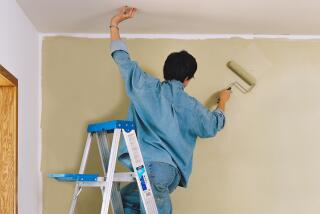Classic Cover-Ups : Old-Fashioned Embossed Wallpaper Is Back in Vogue, Magically Transforming Surfaces
- Share via
Off the wall, it looks stiff and unwieldy and, yes, a lot like linoleum. But once installed and painted or glazed, Lincrusta, the venerable English wall covering that graced the mansions of Rockefeller and Carnegie, works a kind of magic.
Once-plain walls are suddenly three-dimensional, transformed into replicas of carved plaster friezes, hand-tooled leather dadoes, cane, grass matting, linen and even wood-grain paneling.
Lincrusta, a thin version of embossed linoleum mounted on canvas or waterproof paper, was invented in 1877. The first embossed wall covering to be machine-made and mass marketed, Lincrusta and its more cloth-like cousin, Anaglypta, were an instant hit at the turn of the century in England and America.
It was sanitary and durable, and it came in wonderfully imitable patterns. Anaglypta, more pliable and less expensive, followed in 1883.
Never actually off the market, the wall coverings nevertheless fell into disuse in the United States until revived in the 1970s by the first wave of restoration in San Francisco’s Victorian neighborhoods.
Now the products are enjoying a second wave of popularity. Old patterns, once retired, are available once more.
For a firsthand glimpse, look up the next time you visit a Marie Callender’s Restaurant. If it’s not a tin ceiling, it’s probably Anaglypta.
And those with an eye for detail can spot the wall coverings on the sets of such TV shows as “Dear John” and “Frank’s Place,” said Donna Morgan, co-owner with husband, David, of Classic Ceilings in Fullerton. The company sells the products in the western United States.
Both Lincrusta and the lighter embossed papers are still made the old-fashioned way, embossed on heavy presses in the Crown Berger Co. factory in Darwen, Lancashire, the center of England’s wall covering industry.
“People come in here and say, ‘That’s just for Victorian houses, isn’t it?’ But I think you could use it in just about any kind of house. You need walls with a lot of height to carry off the Lincrusta friezes, but the wallpaper goes with any decor,” Morgan said.
Generally, Anaglypta wallpaper is used for ceilings. The best-selling Lincrusta that Classic Ceilings sells is an Edwardian dado introduced in 1906.
Both products are manufactured to be painted, said Matt Bakewell, a Garden-Grove based installer who only works with Anaglypta and Lincrusta. Bakewell, who has been hanging paper for more than 50 years, first hung the embossed paper with his father in Texas when he was 12 years old.
“There’s so few of us who are familiar with it,” Bakewell said. “There’s little tricks to installing it, and you have to be very careful. Lincrusta is harder to work with than the Anaglypta, especially on curves and corners. With regular wallpaper, you can just bend it, but you can’t do that with Lincrusta or Anaglypta.”
Wallpaper retailers say the paper is easy to hang. Just don’t roll the seams, they caution, or you’ll flatten the design. When Nancy Hiser bought Anaglypta for her ceilings five years ago, she considered hanging it herself but decided it looked “a little overwhelming.”
She hired a wallpaper hanger to do the job, but he had trouble with it, and Hiser finally got Bakewell to finish the work on her dining room ceiling and upstairs hallway. The results were viewed by more than 500 people in October when the home, a two-story Craftsman-style built in 1913, was on the Old Towne Orange Home tour.
“I think people are really amazed to find out it’s wallpaper,” said Hiser, who selected the deeply embossed, geometrically patterned paper because it recalls the look of pressed tin ceilings.
Hiser’s decorator, Margaret Allen of Orange, calls the result a nice period effect and a wonderful alternative to tin ceilings at a “reasonably moderate price.”
The wallpaper, which comes in different weights, includes the original cotton and wood pulp paper now called Anaglypta SupaDurable; a lighter-weight, less heavily embossed paper called Anaglypta Original, and two super-light vinyls.
The suggested retail price on the SupaDurable wallpaper is $54 per double roll, according to Morgan. Lincrusta friezes, which come in 33-foot rolls, carry a suggested retail price of $114, she said.
Lincrusta may be expensive, but it is by far the most beautiful of the Crown Berger wall coverings, said Bakewell, adding that it is almost indestructible.
The material once was used to decorate the outside of Pullman railroad cars and can still be found in many American homes after more than 100 years.
The famed Sarah Winchester “Mystery House” in San Jose, a 160-room mansion built over a 38-year period beginning in 1884 by the widow of Winchester firearms magnate William Winchester, has dozens of rooms covered with Anaglypta and Lincrusta.
When it comes to modern use of the English wall coverings, David and Dianne Reidy, who live in central Orange County, seem to have it all.
The couple papered the downstairs ceilings of their hilltop homewith Anaglypta, installed a Lincrusta wainscoting in the entryway to their Victorian music room and hung artfully glazed Lincrusta between the copper-plated tin ceiling and dark oak wainscoting in the music room itself.
The Reidys, who belong to a musical collectors club, have outfitted the 30-by-30-foot room as a Victorian ice cream parlor, complete with an antique soda fountain, stained glass windows and original ice cream parlor lights.
Working on weekends, it took the pair three months to put up the Lincrusta and finish it with a hand-rubbed glaze in a peach-tone pink with eggshell highlighting. Bakewell also worked with the Reidys and installed the Lincrusta, no simple task in itself.
Lincrusta first must be trimmed, then soaked in water, wiped off and put up with heavy-duty wallpaper paste. Because it’s an oil-based product, Lincrusta must be painted with oil-based paints. Latex paint is recommended for Anaglypta, and Bakewell said he prefers a high-gloss paint on ceilings to accentuate the design.
“We chose a pattern we thought was the most elegant and striking for the room,” David Reidy said of the richly detailed Italian Renaissance pattern in the music room.
“Lincrusta is a matter of time, patience and experience. The pattern is there, but it’s up to you to bring out any relief you want,” he said.
The couple plan to use an even more elaborate color scheme involving five colors when they finish the now-unpainted Lincrusta wainscoting downstairs.
“Lincrusta is a very involved process, but it’s rewarding,” Reidy said.
Composed of linseed oil, gum, resin, wax and wood fiber, Lincrusta actually gets tougher with age, becoming hard as a rock, according to Dave Morgan, son of Donna and David of Classic Ceilings. Both products are good for hiding defects, such as cracks in plaster ceilings and walls.
But to the redecorator, perhaps their real glory lies in the fact that they can be repainted. Those who tire of a color scheme don’t have to strip wallpaper and rehang it. They can do it the old-fashioned way--put on a new coat of paint.

